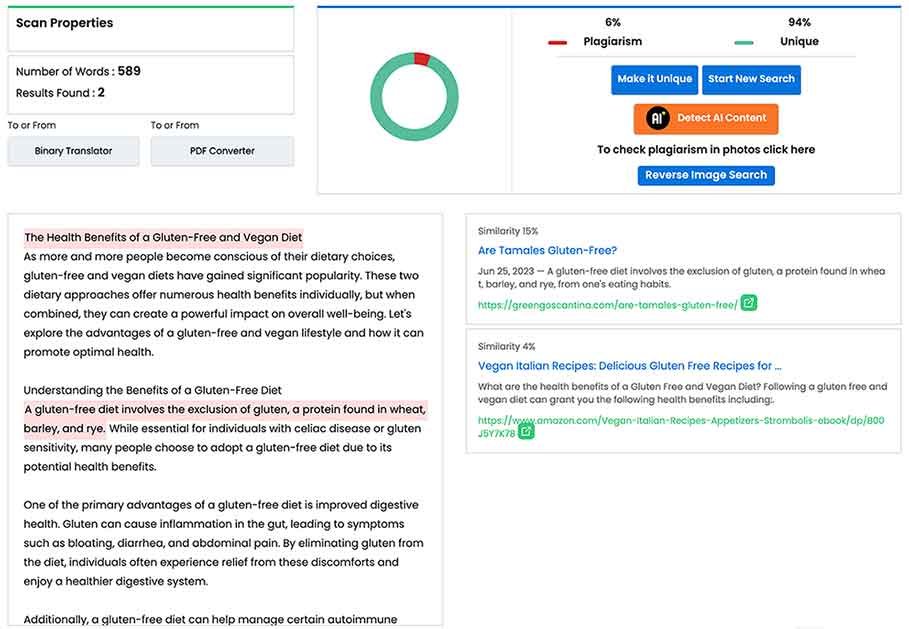
Table of Contents
As businesses strive to maintain originality and integrity in their content, the need for reliable plagiarism checkers has become increasingly crucial. In this comprehensive comparison and review, we explore the best plagiarism checkers available, including their features, benefits, and drawbacks, to help you make an informed decision for your business.
Risks of Plagiarism and Loss of Uniqueness in AI-Generated Content
Plagiarism in AI-Generated Content:
As businesses increasingly turn to AI-powered tools like Media Monk for content creation, it’s crucial to address the risks associated with plagiarism and the potential loss of uniqueness. AI-generated content is typically produced based on vast datasets, including existing articles, posts, and other materials. While this process ensures efficiency and relevancy, it may inadvertently lead to content that closely resembles existing material on the web, risking plagiarism.
- Content Overlap: Given the vast amount of content already available online, AI tools might generate content that is too similar to existing sources, leading to unintentional plagiarism.
- Repetitive Patterns: AI algorithms might develop repetitive patterns or commonly used phrases, which can make content feel generic or derivative.
Losing Uniqueness in AI Content:
Uniqueness is a cornerstone of effective content marketing, as it distinguishes a brand and engages the audience with fresh perspectives. However, when relying solely on AI for content creation, there’s a risk of producing content that lacks a unique voice or fails to stand out.
- Homogenization of Voice: AI-generated content may lack the personal touch or unique voice that reflects a brand’s individuality, leading to a homogenized tone across different pieces of content.
- Predictability: Overreliance on AI might result in predictable and formulaic content, as the AI often relies on patterns and data that have been successful in the past, potentially stifling creativity and innovation.
Mitigating Risks and Maintaining Uniqueness:
To mitigate these risks and ensure the production of high-quality, unique content, businesses should consider the following strategies:
- Human Oversight: Incorporate human review and editing processes to oversee AI-generated content. This ensures that the material aligns with the brand’s voice, checks for potential plagiarism, and maintains the quality and originality of the content.
- Customization and Personalization: Customize AI settings to align with the brand’s unique style and audience preferences. Input specific guidelines, tones, and topics to guide the AI in producing more tailored and distinctive content.
- Regularly Update AI Training: Keep the AI algorithms updated with the latest content trends and company information. Regular updates can help the AI learn and adapt to producing more relevant and unique content.
- Use Plagiarism Checkers: Employ plagiarism checking tools as a part of the content review process to ensure the originality of AI-generated content before publication.
While AI provides an efficient and effective means of content production, it’s essential for businesses to remain vigilant about the risks of plagiarism and the potential loss of uniqueness. By combining the strengths of AI with strategic human oversight and creativity, businesses can leverage AI tools to produce content that is both original and engaging, thereby maintaining a competitive edge in their content marketing efforts.
Top Plagiarism Detection Tools
When it comes to choosing the best plagiarism checker, it’s essential to consider the top plagiarism detection tools in the market. We delve into the features and capabilities of leading tools to provide a comprehensive comparison of their effectiveness in identifying and preventing plagiarism.
One of the top plagiarism detection tools is Checker-X, known for its advanced algorithm that can detect even the most subtle instances of plagiarism. It offers a user-friendly interface and real-time scanning, making it a popular choice for businesses looking to maintain originality in their content.
Price: From $0 to $147.95 (5 Licenses).
NOTE: The product needs to be downloaded and woks off your local computer. No cloud version available.
Another leading tool is PlagiarismDetector, which stands out for its extensive database and cross-referencing capabilities. It is particularly effective in identifying paraphrased content and has a robust reporting system to help users understand the extent of plagiarism in their documents.
Price: Ranging from $0 to $80 per month. Discounts offered for Yearly subscriptions.
NOTE: This product is great but painfully slow to detect content larger than 1000 words.
Plagiarism Checker Comparison
When comparing plagiarism detection capabilities, it is essential to consider the range of sources that each checker can scan. Some plagiarism checkers are limited to only checking against online sources, while others have the ability to compare content against a vast database of academic journals, publications, and other offline sources. This comprehensive comparison allows you to understand the depth and breadth of each checker’s detection capabilities, ensuring that you choose a solution that meets your specific needs.
Accuracy is another crucial factor when evaluating plagiarism checkers. A high-quality plagiarism checker should be able to accurately identify and highlight any instances of copied or unoriginal content, providing you with confidence in the originality of your work. By examining the accuracy of each checker, you can make an informed decision about which one best suits your requirements for maintaining content integrity and authenticity.
In addition to detection capabilities and accuracy, the ease of use of a plagiarism checker is also important to consider. An intuitive and user-friendly interface can streamline the process of checking for plagiarism, saving you time and effort. On the other hand, a complex or cumbersome checker may hinder your workflow and productivity. By evaluating the user experience of each plagiarism checker, you can select a solution that not only meets your plagiarism detection needs but also integrates seamlessly into your content creation and management processes.
How Media Monk tackles the challenge of maintaining uniqueness in AI-Generated Content

Media Monk addresses the challenges of plagiarism and the potential loss of uniqueness in AI-generated content through several proactive measures and features built into its platform. Here’s how Media Monk tackles these issues:
1. Advanced AI Algorithms:
- Original Content Generation: Media Monk employs sophisticated AI algorithms that are designed to generate original content. By learning from a vast array of sources and styles, the AI can produce unique compositions that reduce the risk of creating duplicate or plagiaristic content.
- Constant Learning and Updating: The AI models used by Media Monk are continuously updated with new data and trends, ensuring that the content generated is not only unique but also relevant and fresh.
2. Customization and Brand Alignment:
- Personalized Content Creation: Users can input specific guidelines, tones, and topics unique to their brand. This customization allows Media Monk to tailor content that reflects the brand’s voice and style, maintaining uniqueness and authenticity.
- User Input Integration: The platform encourages users to provide seed information, preferences, and specific instructions that guide the content generation process, ensuring the final output aligns closely with the brand’s identity and content strategy.
3. Human Oversight and Editing:
- Editorial Review: Media Monk acknowledges the importance of human touch in content creation. The platform supports an integrated approach where AI-generated content is reviewed, edited, and refined by human editors to ensure quality, originality, and brand alignment.
- Plagiarism Checks: The platform includes or integrates with plagiarism checking tools to ensure that all content is original and free from unintentional duplication before it’s published.
4. Diverse Content Forms and Sources:
- Variety in Content Production: Media Monk’s platform is capable of producing various types of content, including blog posts, social media updates, and videos. This diversity helps in creating unique content formats tailored to different platforms and purposes.
- Expansive Learning Sources: The AI draws from a wide and diverse set of learning materials, which helps in creating unique and varied content by combining elements from different sources and styles.
5. Continuous Monitoring and Feedback:
- Performance Analytics: Media Monk provides analytics on how content performs, allowing businesses to continuously refine and adapt their strategies. This feedback loop helps in avoiding repetitive or ineffective content strategies.
- User Feedback Incorporation: The platform evolves with user feedback, learning from past interactions and user corrections to improve the uniqueness and quality of content generation over time.
By combining advanced AI with strategic human oversight, customization options, and continuous learning and adaptation, Media Monk provides a robust solution for businesses looking to generate original, high-quality content while mitigating the risks of plagiarism and maintaining the uniqueness that sets their brand apart.


